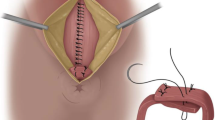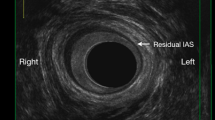Abstract
Purpose
Lateral anal sphincterotomy is the gold standard of surgical treatment for anal fissure. Patients undergoing this procedure are warned about the risk of incontinence; however, there are few reports on long-term outcomes. We conducted this study to investigate long-term outcomes after lateral anal sphincterotomy, focusing specifically on postoperative incontinence.
Methods
Patients who underwent lateral anal sphincterotomy at a university teaching hospital between 1998 and 2004 were sent questionnaires to allow us to assess their continence according to the Cleveland Continence Score.
Results
The response rate was 58 % and the responders comprised 25 men and 13 women, with a median age of 49 years (range 16–82 years). The success rate for fissure healing following surgery was 92 %, being significantly more likely in patients with textbook symptoms (p = 0.016) and those with chronic disease (p = 0.006). The overall complication rate was 13.2 %. Long-term objective and symptomatic incontinence were reported by two (5.6 %) patients, one of whom required a colostomy.
Conclusion
Success rates after lateral anal sphincterotomy were satisfactory, but careful patient selection based on symptoms and disease chronicity may improve results further. Patients with predisposing risk factors for the development of incontinence, particularly multiparous women, are arguably better treated with non-surgical options.
Similar content being viewed by others
References
Poh A, Tan K, Seow-Choen F. Innovations in chronic anal fissure treatment: a systematic review. World J Gastrointest Surg. 2010;2(7):231–41.
Hyman N. Incontinence after lateral internal sphincterotomy: a prospective study and quality of life assessment. Dis Colon Rectum. 2004;47:35–8.
Golfam F, Golfam P, Khalaj A, Sayed Mortaz SS. The effect of topical Nifedipine in treatment of chronic anal fissure. Acta Med Iran. 2010;48(5):295–9.
Karandikar S, Brown GM, Carr ND, Beynon J. Attitudes to the treatment of chronic anal fissure in ano after failed medical treatment. Colorectal Dis. 2002;5:569–72.
Siddique MI, Murshed KM, Majid MA. Comparative study of lateral internal sphincterotomy versus local 0.2 % glyceryl trinitrate ointment for the treatment of chronic anal fissure. Bangladesh Med Res Counc Bull. 2008;34(1):12–5.
Nelson RL. Operative procedures for fissure in ano. Cochrane Database Syst Rev 2010; (1):CD002199. doi:10.1002/14651858.CD002199.pub3.
Karamanlis E, Michalopoulos A, Papadopoulos V, Mekras A, Panagiotou D, Ioannidis A, Basdanis G, Fahantidis E. Prospective clinical trial comparing sphincterotomy, nitroglycerin ointment and xylocaine/lactulose combination for the treatment of anal fissure. Tech Coloproctol. 2010;14(1):S21–3.
Tocchi A, Mazzoni G, Miccini M, Cassini D, Bettelli E, Brozzetti S. Total lateral sphincterotomy for anal fissure. Int J Colorectal Dis. 2004;19:245–9.
Lindsey I, Jones OM, Smilgin-Humphreys MM, Cunningham C, Mortensen NJ. Patterns of fecal incontinence after anal surgery. Dis Colon Rectum. 2004;47:1643–9.
Rockwood TH, Church JM, Fleshman JW, Kane RL, Mavrantonis C, Thorson AG, Wexner SD, Bliss D, Lowry AC. Patient and surgeon ranking of the severity of symptoms associated with fecal incontinence. Dis Colon Rectum. 1999;42:1525–32.
Rockwood TH, Church JM, Fleshman JW, Kane RL, Mavrantonis C, Thorson AG, Wexner SD, Bliss D, Lowry AC. Fecal incontinence quality of life scale quality of life instrument for patients with fecal incontinence. Dis Colon Rectum. 2000;43:9–17.
Goligher JC. Surgery of the anus, rectum and colon. 3rd ed. London: Balliere & Tindall; 1975.
Sileri P, Stolfi VM, Franceschilli L, Grande M, Di Giorgio A, D’Ugo S, Attina’ G, D’Eletto M, Gaspari AL. Conservative and surgical treatment of chronic anal fissure: prospective longer term results. J Gastrointest Surg. 2010;14(5):773–80.
Abd Elhady HM, Othman IH, Hablus MA, Ismail TA, Aboryia MH, Selim MF. Long-term prospective randomised clinical and manometric comparison between surgical and chemical sphincterotomy for treatment of chronic anal fissure. S Afr J Surg. 2009;47(4):112–4.
Sileri P, Mele A, Stolfi VM, Grande M, Sica G, Gentileschi P, Di Carlo S, Gaspari AL. Medical and surgical treatment of chronic anal fissure: a prospective study. J Gastrointest Surg. 2007;11(11):1541–8.
Brown CJ, Dubreuil D, Santoro L, Liu M, O’Connor BI, McLeod RS. Lateral internal sphincterotomy is superior to topical nitroglycerin for healing chronic anal fissure and does not compromise long-term fecal continence: six-year follow-up of a multicenter, randomized, controlled trial. Dis Colon Rectum. 2007;50(4):442–8.
Nasr M, Ezzat H, Elsebae M. Botulinum toxin injection versus lateral internal sphinctertomy in the treatment of chronic anal fissure: a randomized controlled trial. World J Surg. 2010;34(11):2730–4.
Arroyo A, Pérez F, Serrano P, Candela F, Calpena R. Open versus closed lateral sphincterotomy performed as an outpatient procedure under local anaesthesia for chronic anal fissure: prospective randomised study of clinical and manometric longterm results. J Am Coll Surg. 2004;199:361–7.
Yucel T, Gonullu D, Oncu M, Koksoy FN, Ozkan SG, Aycan O. Comparison of controlled-intermittent anal dilatation and lateral internal sphincterotomy in the treatment of chronic anal fissures: a prospective, randomized study. Int J Surg. 2009;7(3):228–31.
Wiley M, Day P, Rieger N, Stephens J, Moore J. Open vs. closed lateral internal sphincterotomy for idiopathic fissure-in-ano: a prospective, randomised, controlled trial. Dis Colon Rectum. 2004;47:847–52.
Kang GS, Kim BS, Choi PS, Kang DW. Evaluation of healing and complications after lateral internal sphincterotomy for chronic anal fissure: marginal suture of incision vs. open left incision: prospective, randomized, controlled study. Dis Colon Rectum. 2008;51(3):329–33.
Garcia-Aguilar J, Belmonte Montes C, Perez JJ, Jensen L, Madoff RD, Wong WD. Incontinence after lateral internal sphincterotomy anatomic and functional evaluation. Dis Colon Rectum. 1998;41:423–7.
Elsebae MM. A study of fecal incontinence in patients with chronic anal fissure: prospective, randomized, controlled trial of the extent of internal anal sphincter division during lateral sphincterotomy. World J Surg. 2007;31(10):2052–7.
Menteş BB, Güner MK, Leventoglu S, Akyürek N. Fine-tuning of the extent of lateral internal sphincterotomy: spasm-controlled vs. up to the fissure apex. Dis Colon Rectum. 2008;51(1):128–33.
Hancke E, Rikas E, Suchan K, Völke K. Dermal flap coverage for chronic anal fissure: lower incidence of anal incontinence compared to lateral internal sphincterotomy after long-term follow-up. Dis Colon Rectum. 2010;53(11):1563–8.
Pujahari AK. Unilateral versus bilateral lateral internal sphincterotomy: a randomized controlled trial for chronic fissure in ano. Trop Gastroenterol. 2010;31(1):69–71.
Ammari FF, Bani-Hani KE. Faecal incontinence in patients with anal fissure: a consequence of internal sphincterotomy or a feature of the condition? Surg J R Coll Surg Edinb Irel. 2004;2(4):225–9.
Arslan K, Erenoglu B, Dogru O, Turan E, Eryilmaz MA, Atay A, Kokcam S. Lateral internal sphincterotomy versus 0.25 % isosorbide dinitrate ointment for chronic anal fissures: a prospective randomized controlled trial. Surg Today. 2013;43(5):500–5.
Casillas S, Hull TL, Zutshi M, Trzcinski R, Bast JF, Xu M. Incontinence after a lateral internal sphincterotomy: are we understanding it? Dis Colon Rectum. 2005;48:1193–9.
Nyam DCNK, Pemberton JH. Long-term results of lateral internal sphincterotomy for chronic anal fissure with particular reference to incidence of fecal incontinence. Dis Colon Rectum. 1999;42(10):1306–10.
Acknowledgments
We thank Mr. R Morgan FRCS and Mr. N Carr MD FRCS for permission to study their patients.
Conflict of interest
Full ethical approval was obtained for the study, no financial support was received and the authors declare no conflicts of interest.
Author information
Authors and Affiliations
Corresponding author
Appendix
Appendix


Rights and permissions
About this article
Cite this article
Davies, I., Dafydd, L., Davies, L. et al. Long term outcomes after lateral anal sphincterotomy for anal fissure: a retrospective cohort study. Surg Today 44, 1032–1039 (2014). https://doi.org/10.1007/s00595-013-0785-0
Received:
Accepted:
Published:
Issue Date:
DOI: https://doi.org/10.1007/s00595-013-0785-0




